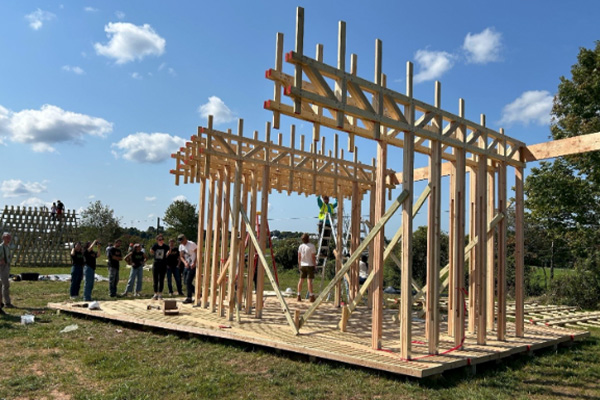HIGHLIGHTS
PROGRAM UPDATES
WoodWorks Pursues Growth Opportunities for Wood in New School Construction Webinar Explores Mass Timber from Developer, Architect, and Engineer Perspectives The AWC Releases 2024 NDS with Commentary, Shaping How U.S. Wood Structures Are Built MLMA-Endowed Professorship Aligns with SLB Education Focus on Expanding Wood EducationProgram Updates
WoodWorks Pursues Growth Opportunities for Wood in New School Construction
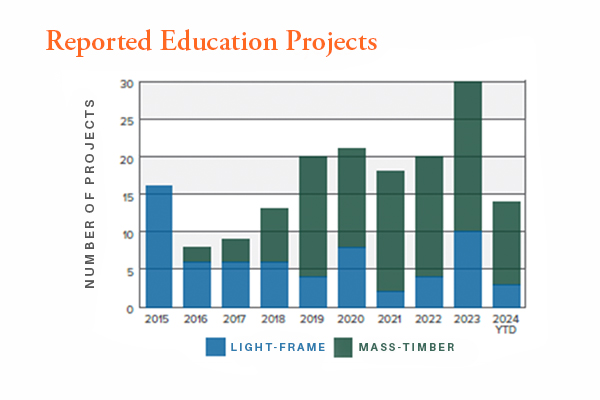
The rising demand for educational facilities presents a significant opportunity for the lumber industry, with a potential market opportunity of 1.7 BBF, according to an outlook prepared for the SLB by Forest Economic Advisors. However, the definition of education is broad and segmentation is necessary to target and capture the opportunities for greater wood use. K-12 projects are the largest sub-category by area and are projected to slightly increase. University projects are expected to remain flat, and laboratory projects, which have been a hot topic in real estate circles, are starting to decline. WoodWorks uses this knowledge to develop resources and determine where the greatest opportunities lie for success.
Schools have always been part of the WoodWorks mix, and 169 projects have been reported since 2015. Light-frame has remained strong as a viable option, and the emergence of mass timber has spurred additional opportunity in select regions, which WoodWorks sees through its own data. In 2021, WoodWorks provided support on three light-frame wood schools, while in 2023 the number was 10. Comparatively, mass timber schools supported by WoodWorks also grew, from 15 in 2021 to 20 in 2023. 2024 is off to a strong start with 14 schools reported in the first half of this year.
Despite challenges such as budget constraints and perceived concerns about durability, the push for sustainability, aesthetics, and biophilia continues to drive mass timber adoption in schools, while cost is a major advantage for schools designed with light-frame construction. This promising market-expanding trend is demonstrated by the Mass Timber Competition-winning project Evergreen Charter School. The 85,000-square-foot, five-story hybrid CLT education facility with biophilic design elements is planned for completion by the end of 2024.
Webinar Explores Mass Timber from Developer, Architect, and Engineer Perspectives
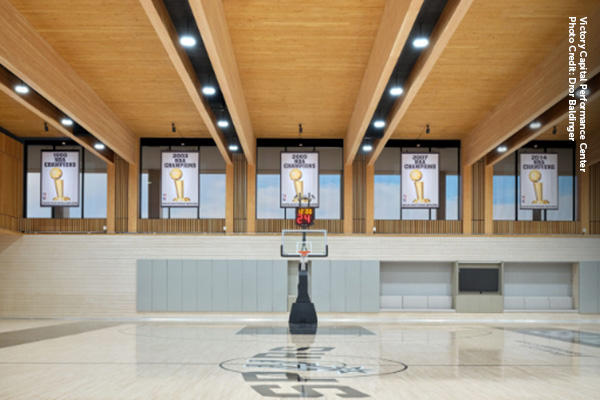
A recent Think Wood webinar, Mass Timber 2030: Preparing Your Practice, brought a unique perspective to the topic of mass timber design by uniting three different stages of the project pipeline in a discussion group moderated by Think Wood’s Director Katie Gerfen.
The webinar, which targeted architects interested in specifying mass timber, prepared the audience for how to deal with questions from other AEC professionals that might derail that specification. Alex Ohrn, a Managing Director for the development firm Hines, discussed his firm’s approach to mass timber—primarily through its well-known, repeatable T3 model with 27 locations finished or in the works—from a business perspective, exploring the impact of mass timber on a project’s value and ROI. Kai-Uwe Bergmann, a Partner with architecture firm BIG – Bjarke Ingels Group, offered advice on how other architecture firms can expand their mass timber expertise and use it in more projects by leveraging his own firm’s experience using mass timber in European projects and later incorporating wood structural systems into its U.S. projects. John Hand, Associate Principal at the engineering firm Arup, described how designers can overcome hesitation within their firm or from clients about the swiftly evolving nature of connections, acoustics, fire protection, and other design principles.
“It is our belief that investing more in a better quality product will get a value premium, whether that’s through tenants willing to pay more of the rent, whether it’s operational savings, or just long-term value appreciation,” Ohrn said on the panel. “We said, ‘Let’s pay a little bit more and go mass timber,’ and we’re leading the market in the rents that we’re getting here.”
After hosting the webinar for a live audience of architects from the 26 largest AEC firms in the U.S., Think Wood will be use an on-demand version of the webinar for future lead nurture and continuing education both on the Wood Institute and with media partners, where it will help push existing leads further toward specification and generate new contacts for the Think Wood campaign.
The AWC Releases 2024 NDS with Commentary, Shaping How U.S. Wood Structures Are Built
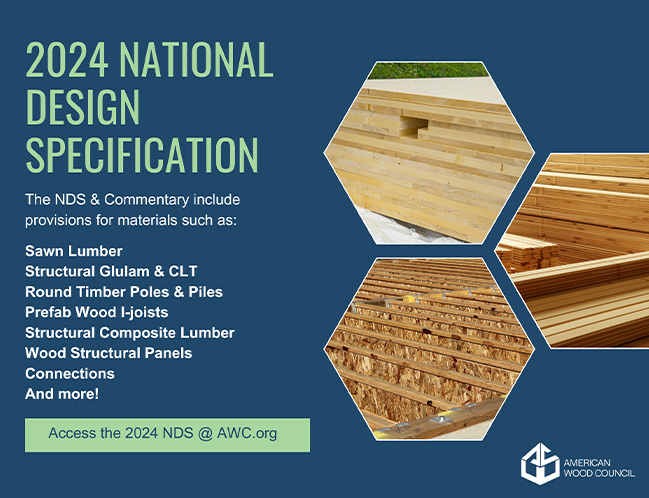
Standards are the principal building blocks of the AWC’s work in the building code development process. The AWC maintains an ANSI-approved consensus process where interested parties update AWC’s wood design standards, which are referenced in the building code. In essence, to properly design and build a wood structure in the U.S., someone must use AWC’s design standards.
The AWC’s 2024 edition of the National Design Specification® (NDS) for Wood Construction with the 2024 NDS Commentary is one such standard that was recently made available for purchase and download on the AWC’s website. The NDS is referenced in the 2024 International Building Code and the 2024 International Residential Code and serves as the primary design standard for wood structures designed and constructed in the U.S.
The 2024 edition of the NDS includes key updates for the design of shear in bending members and design of connections with four or more members, as well as changes to Chapter 16, which sets provisions for the fire design of wood members that align with the 2024 Fire Design Specification (FDS) and references the FDS for more complex design situations. The newly released NDS Commentary provides additional information to support the NDS requirements and assist design professionals and code officials in understanding the NDS provisions.
The ANSI/AWC NDS-2024 with Commentary is available for free view and for purchase on the AWC website.
MLMA-Endowed Professorship Aligns with SLB Education Focus on Expanding Wood Education
SLB Education’s focus on expanding wood education in post-secondary architecture, engineering, and construction management programs works in tandem with efforts by regional lumber organizations and individual investors with influence at their local institutions. This collaboration is vital as an SLB audit found that 59% of schools provide little to no exposure to wood design.
A recent example of this regional focus is a gift from the Mississippi Lumber Manufacturers Association (MLMA), creating a new endowed professorship in Innovative Wood Construction and Design at Mississippi State University (MSU) that aims to spread awareness and further research on mass timber as a viable and sustainable innovation for the timber industry.
In an interview with MSU, Trey Hankins, CFO of Hankins Inc., MLMA vice president, and an incoming SLB director, described how mass timber products such as CLT allow designers to create tall wood buildings that are strong, safe, and beautiful, but he notes the technology still faces obstacles to mainstream adoption.
“CLT technology originated in Europe,” Hankins says. “For many years, importing mass timber products was the only way to obtain them, which slowed its adoption here in the U.S. Now, the U.S. does have domestic mass timber plants, but there is still limited knowledge and experience building with it. We knew we needed to find a way to help bridge that knowledge gap.”
The endowed professorship will focus on teaching, research, and outreach, promoting CLT and other innovative wood technologies to the next generation of builders and producers. It’s a move that complements SLB Education’s work to develop faculty proficient in wood design and construction. Through a series of faculty workshops, SLB Education will have equipped nearly 300 new faculty members by 2025 with cutting-edge knowledge to incorporate wood design into their curricula.
Spotlight
Architecture Students Are Embracing SLB Programs’ Environmental Message on Wood
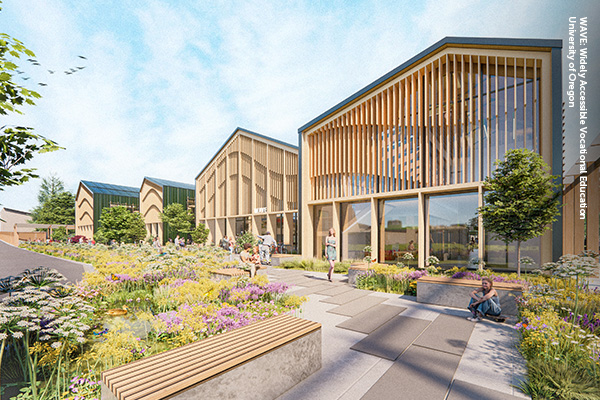
In a sign that the SLB and its funded programs’ messages about wood construction’s environmental benefits are reaching students—even in programs that don’t specifically call for wood construction—nine out of 10 winners of the 2024 COTE Top Ten for Students Competition use wood in a meaningful way. An entry called WAVE: Widely Accessible Vocational Education Center (pictured above) from the University of Oregon, for example, proposes the use of sustainable mass timber throughout a collaborative learning building on a high school campus in Portland, Oregon.
The student version of the American Institute of Architects Committee on the Environment’s (AIA COTE’s) prestigious Top Ten awards is focused on sustainability, challenging students to create designs that protect and enhance the environment. It’s run in partnership with the Association of Collegiate Schools of Architecture (ACSA), an organization that the SLB partners with for its TIMBER IN THE CITY student design competition and Timber Education Prize recognizing innovative coursework and curricula involving wood design.
SLB Education is rapidly expanding the footprint of its impact at post-secondary institutions, with 52 faculty from 42 architecture and engineering programs participating in faculty workshops in 2023 and 80 faculty members from 60 schools participating so far this year. In addition, the Think Wood Mobile Tour made a total of 30 stops in its four-year run, including many campuses. The long-term impact of those engagements are now being felt: six of the nine winning projects using wood were from universities that the SLB has partnered with to host faculty workshops or stops on the Think Wood Mobile Tour.
Industry Resources
FEA's Housing Dashboard
This housing dashboard is provided compliments of Forest Economic Advisors (FEA).
View the October Housing Dashboard
Virginia Tech's Monthly Housing Report
This monthly housing commentary report is a free service of Virginia Tech and is intended to help one gauge future business activity in the U.S. housing market.
August 2024 Reports (released in October 2024)
Part A: August Housing Commentary
Part B: August Economic Conditions


